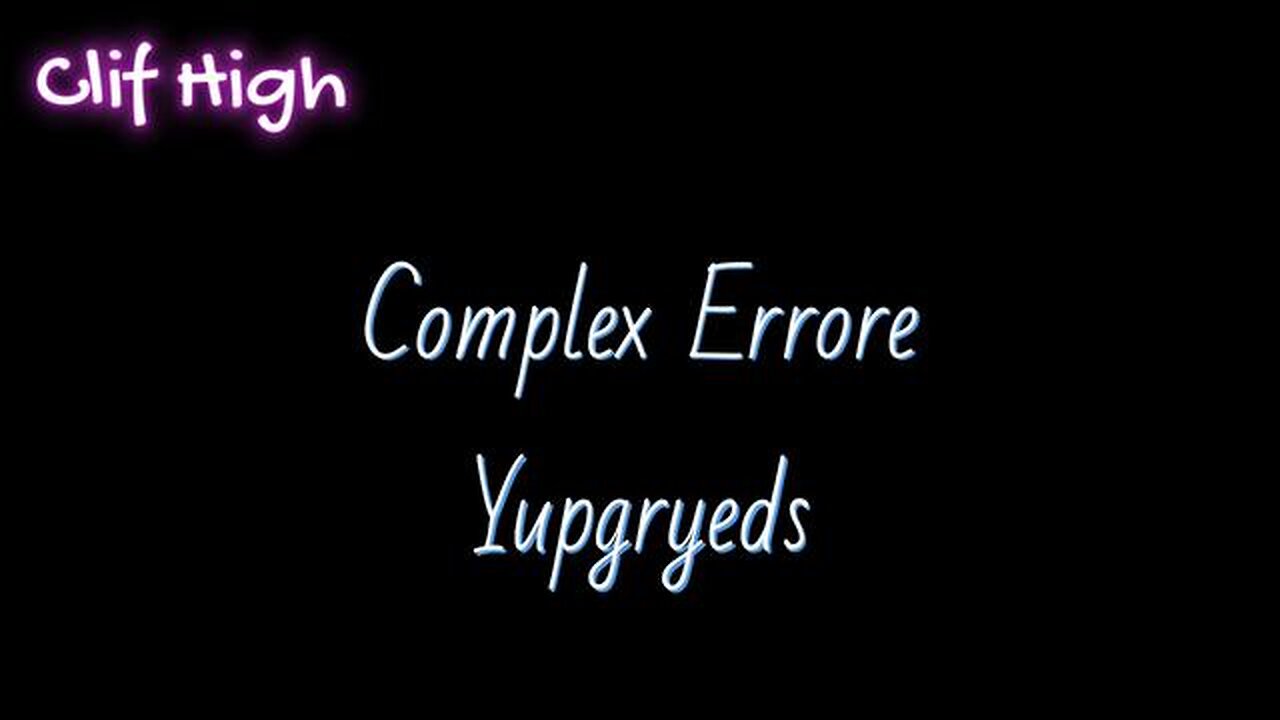Premium Only Content

Clif High - Complex Errore Yupgryeds
M9 bites oure azzez.
Hello, humans. Hello, humans. It's May 11th. It's around 10.30 or so. I've spent a frustrating 15 or 20 minutes trying to get Zoom to update out here so that I could connect with Vlad from Ireland, who's not in Ireland at the moment. He's...
elsewhere on the continent in Europe. But it didn't make any difference. The updater keeps failing, so every time I tried to run Zoom, it would reach a critical point and crash. We're going to try something else and reschedule. All kinds of stuff going on, obviously. It's the first morning after
our first exposure here of the solar flares, right? The waves of them. Having some tea out here and taking the sun at the moment. It's nice to get some and make some vitamin D. Anyway, so...
We passed the M9 point, right? It has nothing to do with May. It's not like May 9th. It just was coincidental that we actually probably passed it on the 8th. And I say probably because here's our situation. We have no ability to see our own galaxy, right? We have to make a lot of inferences as to what our galaxy looks like, where we're at within it, and this kind of thing.
We have to infer an approximate point of the absolute center of the galaxy. We have to infer an equatorial line out from that. And we have to estimate and guess...
at a lot of the angles of radiation that are coming out from this tall column of hundreds of millions of suns that is in the middle of our Milky Way galaxy. Okay, so the concept is that we have this giant column of perhaps hundreds of millions. We just don't know because the light's so bright we can't differentiate. Hundreds of millions of suns in a relatively concentrated area
in the center of the galaxy that is sending out waves of radiation that are more than simple light. There are complex magnetic currents and complex electrophotonic currents. Okay, so photons and electricity all joined up together. Anyway, so the obscuring mass of our galaxy keeps our
our planet and our solar system in the dark, so to speak, for 2400 years. We're out of that 2400 years by some 326 years, and we're now receiving more energy from galactic center. This is what's caused our sun to go from yellow to white over the last part of the 80s and to the current point in its existence.
And this is what accounts for all kinds of strange things that have been going on, including strange radiation, new energies from space that have been hitting our planet since about the year 2000. All right, so it's a very complex situation. This complex situation has us now having crossed a particular point. This point was called M9. As I say, it doesn't relate to May 9th. It was just coincidental it was on the 9th.
We're around there. This is nine. This is a moment of arc. That's why it's M and it's nine. It's nine degrees up off of the presumed absolute center of our galaxy.
and it's nine degrees of arc where Earth's solar system is at relative to that presumed point of the galaxy and relative to the presumed equatorial plane of the galaxy. And as I say, we don't have a camera sitting out somewhere off to the side of our galaxy that can get into a profile and take pictures. We're doing all this mathematically.
So here's the situation. There was this mathematician. I won't go into all the details. It's too tedious. But anyway, there was this Russian guy. This Russian guy, he was a contemporary of Vernadsky. And I think, yeah, and also...
Well, anyway, so he was a mathematician. He was an astrophysicist. And he ran into these Hindu fellows that knew about the yugas. He was in India at the time. He came up with some math that basically remained in India, although it was published in a Russian journal we found from the 60s. You have to understand... Okay, so anyway, the math was...
where in our arc our sinusoidal arc around the outside edge of the galaxy where in arc moments would we rise up high enough that from that point on we wouldn't dip down and get lesser radiation bear in mind our spiraling cometary fashion being drugged behind the sun um uh movement through space um
The angle of that relative to the equatorial plane of the galaxy provides us with our precessional angles. And because of that, our spiraling motion behind our sun caused us to go into the greater energies from the galaxy and then come out of them as we've been spiraling around behind our sun. But now Earth, along with the inner planets...
have risen up high enough that we're through this M9 point. It's actually the M9 plane. It's a complex mathematical construction that basically means from this point forward,
the Sun, all of the inner planets, and Earth and the Moon are 100% going to be bathed in all the time, 24 by 7, new energies from space that are coming to us by way of galactic center. Okay, as our solar system progresses through time over the next couple of years, we'll eventually get to the point where
all of the outer planets, as well as the shell of the solar system itself, the cell-like wall that surrounds our entire solar system, all of that will be beyond the M9 point. So the whole solar system is not there yet. I'll have to go back and look at some of my notes, but I think the calculation was that it was like 28 to 49 months after Earth passed this point that
the rest of the solar system would do it. Now, we have to, again, estimate because we don't know how big the shell is in a trailing fashion beyond in our solar system because of the nature of NASA and the astrophysicists who don't really have the same kind of view of things. Anyway, though, so we're now beyond the M9 point.
It's interesting that we get all these flares just as this part of the mass of the solar system is pulled beyond that point of the obscuring mass of the galaxy. So for here, for the next 10,000 years, we'll be in a rising and then gradually arcing down galaxy.
and then gradually running down arc that will bring us back to the M9 point. I think in about 10,500 years, I'd have to go and look at it. You know, look at the math here. But anyway, so we're going to be in a rising arc for a while, and then we'll go into a descending arc. So when we get to the final top of our arc, that's the golden age. That's when we're up high enough that
We get the full blast, or whatever we're allowed, of the galactic center emanations. Between here and there, we will see all different kinds of changes happen to humanity, happen to the Earth, happen to all these other species. These predictable periods are coincident with species blooms.
New species popping up and stuff. In my opinion, it is this Kali Yuga pattern and the effect of the galactic center emanations that accounts for what we think of as evolution, right? As a steady state pressure of advancement, right? And there's never any discussion by the evolutionists as to why that should exist, okay? Why there should be that selective pressure.
But in any event, so we can put that behind us and go on with our astrophysics. Okay, so Earth is now beyond the M9. The moon is beyond the M9 point. This nine degrees up off the galactic plane means that we're receiving a steady stream of these energies. But it's more than that because we've actually reached a...
one of these other predictable thresholds. It's very complicated and very complex, but one of these other predictable thresholds of increased energy from galactic center. All right, so this is the concept on this.
So galactic center is not like a ball. It's more like a dumbbell. Okay, the old style dumbbells with a bulbous end on each end and a sort of tapering to the thinnest point in the middle shape. Okay, and this is the effect of the plasmoids.
the plasmoid. So you have plasma, and if you get two or three or four plasmas together, you can create a plasmoid field in which all of the plasmoids, all of the plasma, interreact with something greater than themselves. Plasmoids are very interesting because they can persist even if some of the plasmas that initially triggered them off are removed.
Anyway though, so there's this dumbbell kind of shape. So as we rise up,
Even into the Golden Age, we will continue to get increasing levels of radiation that we're not feeling now because we will be, and I'll put this in air quotes, we will be horizontally even with these new areas of radiation. It doesn't really quite work that way, but that's the concept, that we have a very tall, thin kind of giant collection of suns. And as we rise up on the edge of this horizon,
obscuring mass of the galaxy and beyond it up into this area, we get more and more of these rays of radiation. But they're, to a great degree, they're stratified. And so as we go through these various different layers, we will keep receiving more and more and more up until the top part of the arc. Then we'll persist in the top part of the arc for a period of time, which we call the Golden Age. And then we'll start going back down
through the edge of the Golden Age into silver into bronze, which is where we're at now. Then we'll eventually cross the M9 point going downward, and then we will go back into the Kali Yuga. And that's where we're at now.
The ravens over here bitching at me. I'm not giving them any food. But, you know, it's like, hey, guy, there's a clam dig going on. Go out and get a bunch of cast off from all the humans. Anyway, so... Okay, so...
This was why I did the discussion on the substack about will Tonga rule the world, right? Because we're in an increasingly perilous time relative to our computer chips and solar activity and dependence on the computer chip structure.
Okay, so as we get into this period of time, we're actually in the strata of the increased energies from a galactic center, these emanations, we will find, we will discover that they are coincident with
increases in complexity in the form of like orders of magnitude jumps. All right. So we used to live in a simple world. Our simple world had simple mechanical motions and stores of energy in the form of like, you know, a wound spring, a rope and a weight on a complex pulley system.
gunpowder even, you know, which is basically a store of energy in order to produce gas that then propels the bullet out of the gun. And so this was a relatively simple world. You could sort of, to some great degree, expect to recreate your tools no matter where you ended up on the planet, right? Let me see if we're still recording.
Yeah. So you could, you know, if you were a bow and arrow guy, no matter where you went, you could probably reinvent your bow and arrow. Okay. At some point we cross over to where we start using our tools to make better tools. And then it starts getting into our heads to not only systemize the tool making, but systemize the process by which we make tools. And that was a level of complexity step up.
Then we go, you know, 150, 200 years to where we're at now. And we have many other layers of complexity, but we're still
in the process of basically systematizing our own system, so to speak, right? Creating new ones and so on. The M9 point is coincident with, in my opinion, an uptick, an up-leveling, a shift over of our social order into a greater degree of complexity. So it used to be we had simple systems, and then we lived in a simple world with complicated systems.
And then we lived in a complicated world right now with complicated systems. Like, you know, you can think of the air traffic control, right? It's many, many different systems to get an airplane in the air as we see, and many more required to sustain it in the air as Boeing is proving every damn day.
And so we see that now we're into a period, though, where we're going to shift over into complex, complicated world, okay? Or a complicated, complex world. So complexity will be at its root. And we're starting to see some of those expressions. So...
We are actually in a period of time now where ideology can bring down airplanes, as we see with all of the DEI didn't earn it and Wokonian culture appropriation kind of shit going on in corporations. So in that sense, the nature of the...
Consensus mind affects the complex system that it's interacting with, that it's supporting or creating or so on. And now we also have complicated complex systems where all of the systems are all interconnected, right?
Now, I think everybody understands or grasps to some degree the nature of the complications involved in networking and this kind of thing in our reality.
including the networking, going into, you know, payment systems, fiat currencies, banks, and all of this kind of thing. And we also grasp the fragility of that in the sense that, you know, a solar flare of sufficient size, sufficiently aimed, could bring down our banking system, which would cause ripple-on effects throughout the whole of our system of systems. This is a Baudrillard example.
concept from the early 1900s was the system of systems. Vernadsky refines all of those ideas with Neosphere and brings in a bunch more. And anyway, they're attempting to describe, before getting here, the situation we find ourselves in now. As we cross over through this M9 point, we're going to shed off a lot of the crapola that has accumulated in these past few years.
past few decades as a result of the communist infiltration and their long march through our institutions.
All of communism, all of socialism, all of these kind of ideologies are in the process of failing. They are failing for a wide variety of reasons inherent in their makeup and their nature, but they're also failing because of who was their creator and what's going on relative to the...
the more abstract aspects of humanity. So it is true to a certain extent that worshipping space aliens, the Elohim, is going to cause communism and socialism to disappear, and Zionism. Zionism is just another form of Marxism or fascism with a central focus, that's all. Anyway, so the rundown here is this.
That we're entering a period of time where as we pull ourselves out of the mental morass, the mind virus that as Elon describes it, we're going to engineer or find ourselves engineering complexity.
designing complexity working with complexity and to a certain extent disappearing into complexity because the nature of complexity is such that you know how things work down to some degree but it goes black box from that point forward because you've never needed to or had to investigate that and that stuff that's in the black box developed before you got it in
So this is basically the way that all software works now. You have the activation code, the point of the address within the software routine that actually tells it to execute.
But there are other approaches to getting in and having that routine execute through these various different APIs, these hooks. And thus, any chunk of software could be used by any other chunk of software and would remain, its internal workings would remain obscure and obtuse.
to the new user, the new software engineer, new software programmer that was just using these routines because they didn't write it. They've never had to investigate it. They just look at the specified input and the specified output. And that's really all they need bother with at this stage. But we're coming up into a period of time where we're going to get ourselves into trouble with this approach. Okay. And so
I actually think we'll compensate for this by using AI as like a black box scope, like a black box x-ray. And to be able to x-ray into code and complex systems where we have not gone down that far from our particular job as system engineer or system designer. And I think that's the logical way we'll have to evolve with this.
But the idea is that we're going to have all of our errors and our mistakes taken up leveling with us into this complex world. And this will be very dangerous. We'll get through it. We'll undoubtedly have to make a few of these mistakes. And the idea getting across here is that our...
level of complexity of error and errors within complexity will be such that we might find weird kind of connections where the unanticipated interconnection of complex systems produces pathways to error that are not within any system itself.
And systems engineers will understand what I'm speaking of. Probably not a lot of other people will. But the idea is that we'll get through this period of time of all of the planes crashing and that kind of stuff. Maybe we'll go through and get into...
anti-gravity vehicles, and we'll have floating tourist RV buses, that kind of thing, right? We'll evolve some level of complexity along that. But at some point, our level of interdependency of complex systems upon each other will promote a number of internal errors that are potentially unhandled to the level of system affecting aberrant behavior that can then propagate itself through other systems and induce really bizarre behavior.
So it's conceivable that, you know, you could have strange sets of circumstances where an unhandled exception in an Uber program payment schedule ends up shutting down some other major system that would not seem to be connected to it at all. That kind of thing. So, you know, just because they didn't handle the ability to convert to some kind of currency on, you know, a payment system over here in this grocery store,
it turns out that a whole port system shuts down. That kind of thing. And we'll have to have experts that'll come on in with AI to diagnose this shit and figure out where it all tracks back down to. We'll get better at it, and then we'll eventually...
engineer safeguards into it as we go forward, mostly probably initially by wrapping layers of other referential integrity check software around it all. But in any event, we're there now. M9 marks this point in the transition of humanity to our future. We're dropping away off of all of the
you know, the Vax bioweapon death and all of that kind of shit. We're getting through it. We're at the tail end. It's going to drag us down for a while. And we'll be emerging out on the other side. In this process, as I say, we will discover that we've made a transition into complex system world, not merely complicated system world. And complicated system world was bad enough.
Anyway, guys, I've got to get moving and get some stuff done here. So I'll talk to you later. Got to go and do some of my own debugging. I always used to really like that. It was a good occupation. Good aspect of the occupation doing software was debugging very large programs. It was just fun, like a giant puzzle. You know, where is this weird behavior coming from?
that kind of thing. So there will be a lot of opportunity for people in these new system interpenetration complexities. Anyway, I got to get moving. People are here. Okay.
https://clifhigh.substack.com/p/complex-errore-yupgryeds
REPUBLIC RISING
-
 2:07:44
2:07:44
Inverted World Live
5 hours agoPentagon Says it Solved UFO Cases, Tyler Robinson "Roommate" Missing | Ep. 113
27K14 -
 2:30:00
2:30:00
Badlands Media
12 hours agoDevolution Power Hour Ep. 392: Psyops, Paper Tigers, and the Path to Sovereignty
81.4K11 -
 3:02:08
3:02:08
TimcastIRL
6 hours agoLeftist Terror Attack On ICE In Dallas, Jimmy Kimmel Doubles Down Insulting MAGA | Timcast IRL
337K137 -
 1:17:35
1:17:35
Man in America
11 hours agoIs Starlink RIPPING Us Apart from the Inside Out? w/ Cory Hillis
41K14 -
 55:40
55:40
TheSaltyCracker
5 hours agoIdiots Chug Tylenol PT2 ReeEEStream 9-24-25
94.3K221 -
 5:55:01
5:55:01
Akademiks
6 hours agoYoung Thug Dissing YFN Lucci. Ready to Go back to Jail. Offset vs Cardi b
57.9K2 -
 7:07
7:07
Colion Noir
14 hours agoCalifornia Just Banned All Glocks
47.6K40 -

Adam Does Movies
7 hours ago $1.17 earnedTalking Movies + Ask Me Anything - LIVE
39K1 -
 1:23:56
1:23:56
Jamie Kennedy
5 hours agoChoosing Good in a World Gone Dark | Ep 223 HTBITY with Jamie Kennedy
33.9K6 -
 6:54:11
6:54:11
SpartakusLIVE
8 hours ago#1 Challenge CHAMPION of WZ || Ridin' The GRAVY Train w/ GloryJean
73.4K1